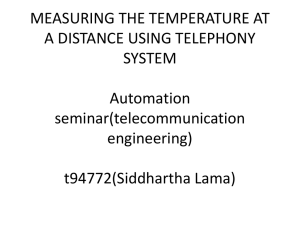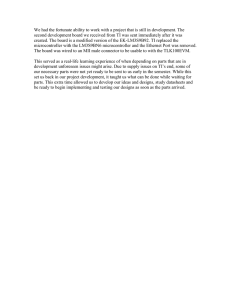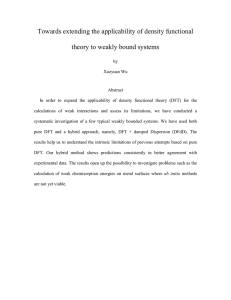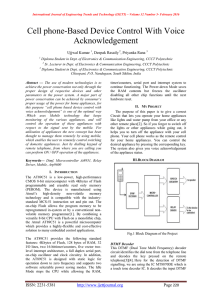Development of a cell phone based remote control system: an
advertisement
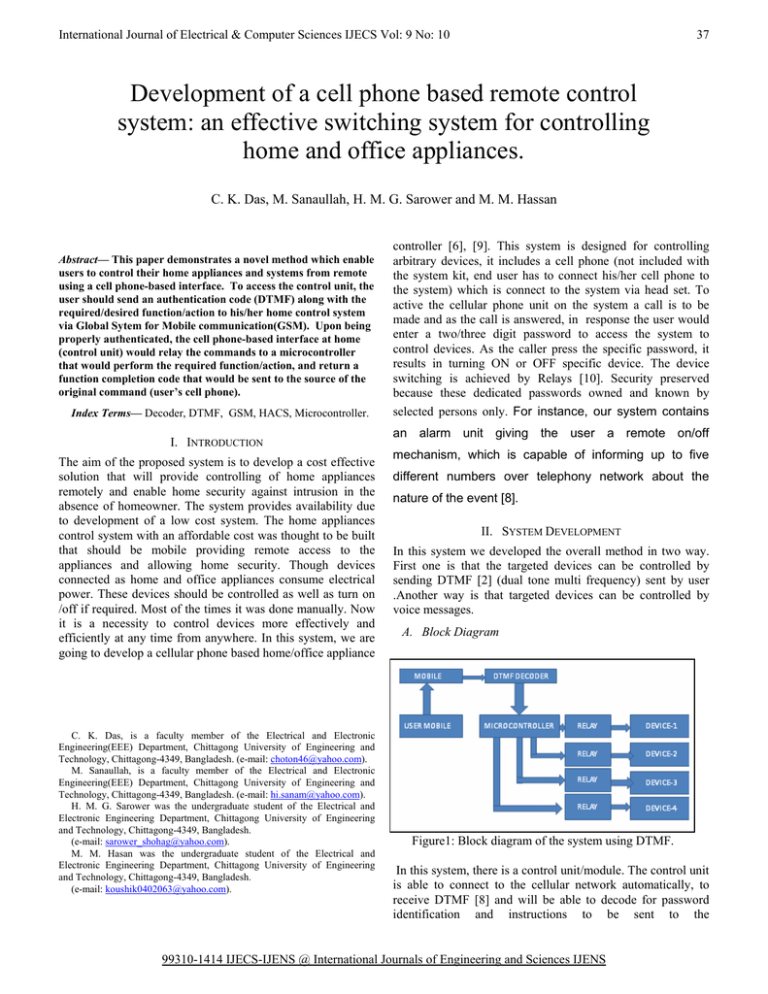
International Journal of Electrical & Computer Sciences IJECS Vol: 9 No: 10 37 Development of a cell phone based remote control system: an effective switching system for controlling home and office appliances. C. K. Das, M. Sanaullah, H. M. G. Sarower and M. M. Hassan Abstract— This paper demonstrates a novel method which enable users to control their home appliances and systems from remote using a cell phone-based interface. To access the control unit, the user should send an authentication code (DTMF) along with the required/desired function/action to his/her home control system via Global Sytem for Mobile communication(GSM). Upon being properly authenticated, the cell phone-based interface at home (control unit) would relay the commands to a microcontroller that would perform the required function/action, and return a function completion code that would be sent to the source of the original command (user’s cell phone). Index Terms— Decoder, DTMF, GSM, HACS, Microcontroller. I. INTRODUCTION The aim of the proposed system is to develop a cost effective solution that will provide controlling of home appliances remotely and enable home security against intrusion in the absence of homeowner. The system provides availability due to development of a low cost system. The home appliances control system with an affordable cost was thought to be built that should be mobile providing remote access to the appliances and allowing home security. Though devices connected as home and office appliances consume electrical power. These devices should be controlled as well as turn on /off if required. Most of the times it was done manually. Now it is a necessity to control devices more effectively and efficiently at any time from anywhere. In this system, we are going to develop a cellular phone based home/office appliance C. K. Das, is a faculty member of the Electrical and Electronic Engineering(EEE) Department, Chittagong University of Engineering and Technology, Chittagong-4349, Bangladesh. (e-mail: choton46@yahoo.com). M. Sanaullah, is a faculty member of the Electrical and Electronic Engineering(EEE) Department, Chittagong University of Engineering and Technology, Chittagong-4349, Bangladesh. (e-mail: hi.sanam@yahoo.com). H. M. G. Sarower was the undergraduate student of the Electrical and Electronic Engineering Department, Chittagong University of Engineering and Technology, Chittagong-4349, Bangladesh. (e-mail: sarower_shohag@yahoo.com). M. M. Hasan was the undergraduate student of the Electrical and Electronic Engineering Department, Chittagong University of Engineering and Technology, Chittagong-4349, Bangladesh. (e-mail: koushik0402063@yahoo.com). controller [6], [9]. This system is designed for controlling arbitrary devices, it includes a cell phone (not included with the system kit, end user has to connect his/her cell phone to the system) which is connect to the system via head set. To active the cellular phone unit on the system a call is to be made and as the call is answered, in response the user would enter a two/three digit password to access the system to control devices. As the caller press the specific password, it results in turning ON or OFF specific device. The device switching is achieved by Relays [10]. Security preserved because these dedicated passwords owned and known by selected persons only. For instance, our system contains an alarm unit giving the user a remote on/off mechanism, which is capable of informing up to five different numbers over telephony network about the nature of the event [8]. II. SYSTEM DEVELOPMENT In this system we developed the overall method in two way. First one is that the targeted devices can be controlled by sending DTMF [2] (dual tone multi frequency) sent by user .Another way is that targeted devices can be controlled by voice messages. A. Block Diagram Figure1: Block diagram of the system using DTMF. In this system, there is a control unit/module. The control unit is able to connect to the cellular network automatically, to receive DTMF [8] and will be able to decode for password identification and instructions to be sent to the 99310-1414 IJECS-IJENS @ International Journals of Engineering and Sciences IJENS International Journal of Electrical & Computer Sciences IJECS Vol: 9 No: 10 microcontroller. The microcontroller [5] within the control unit will issue the command to the electrical appliances through a simple control circuit. B. Circuit Diagram 38 and the MC activates the voice message unit. The MC also sends a deactivation signal when the recorded message is played back. This operation continues in the same manner until the last call is performed. The speaker output of the ISD is connected to the cellular phone speaker so that the recorded message is directly heard by the receiving end of the phone that has been called. Figure2:circuit diagram(1) for the system. Figure4: Circuit diagram for voice message. Figure3: circuit diagram (2) for the system. In the circuit diagram, the system’s mechanism has described. Here, a cell phone is connected in the control unit via headset. When a call is made the cell phone in the control unit auto answered. Then password is being pressed. These DTMF decoded by a dedicated decoder MT-8870 (shown in Figure2: circuit diagram (1) for the system).Then decoded output sent to the microcontroller, which issues command to control devices connected to it(shown in Figure3: circuit diagram (2) for the system). Device switching is performed by relay. D. The DTMF Generation And Decoding DTMF is Short for Dual Tone Multi frequency and the system used by touch-tone telephones. DTMF assigns a specific frequency (consisting of two separate tones) to each key so that it can easily be identified by a microprocessor. C. Voice Message Circuit The circuit diagram for the voice message unit is shown in Fig4.When the microcontroller detects a triggering signal from the scanned units, the numbers recorded on Figure5: Typical DTMF keypad the SIM card of the mobile phone are called sequentially 99310-1414 IJECS-IJENS @ International Journals of Engineering and Sciences IJENS International Journal of Electrical & Computer Sciences IJECS Vol: 9 No: 10 DTMF generation is a composite audio signals of two tones between the frequency of 697Hz and 1633Hz [2], [3]. The DTMF keypad is arranged such that each row will have it’s own unique tone frequency and also each column will have it’s own unique tone. The figure-5 is a representation of the typical DTMF keypad and the associated row/column frequencies. The tone frequencies were selected such that harmonics and intermodulation products will not cause an unreliable signal. The DTMF spectrum is shown in figure-6. 39 that how much energy is present for each frequency of the input signal. In other words, we have computed the frequency spectrum at the 8 DTMF composite frequencies. The reason why this works so well is because of the "orthogonality" of the sine waves. In other words, this happens if the DFT is performed on two sine waves as shown in the following equation: DFT = ∑[sin(f1t) sin(f2t)] ……………………………….(3) From equation (3), it is clear that we will get the result as a "large" number if the two frequencies are the same and a "small" number or zero if they're different. "DFT" With Square waves[4] The orthogonality concept applies equally well to square waves too. In fact, it's even easy to illustrate with ASCII art. Let us consider the two examples as given below: 1) Figure6: Dual Tone Multi Frequency(DTMF)spectrum. As the above frequency spectrum illustrates, each tone must fall within the proper bandpass before a valid decoding will take place. If one tone falls outside the bandpass spectrum, the decoder will become unreliable or not operate at all. The purpose of DTMF decoding is to detect sinusoidal signals in the presence of noise. In many cases, the DTMF decoder IC interfaces with a microcontroller. Here it is logocal that the microcontroller should not be used to decode the sinusoids. Because the typical microcontroller based decoder requires an A/D converter. In addition, the signal processing associated with the decoding is usually beyond the scope of the microcontroller's capabilities. So the designer is forced to use the dedicated IC or upgrade the microcontroller to perhaps a more costly digital signal processor. The theory is quite similar to the "classical" signal processing technique[4]. One brute force way to detect DTMF signals is to digitize the incoming signal and compute 8 DFT's (discrete fourier transforms) centered around the 8 DTMF composite frequencies. DFT's are preferred over FFT's because the frequencies are not equally spaced (in fact, they are logarithmically spaced). In its simplest form, the DFT goes something like so: N DFT(x) = ∑ x(k) W(k)………………………………(1) where x(k) are the time samples and W(k) is the infamous kernal function: W(k) = e(j2πfk/N) = cos(2πfk/N)+ jsin(2πfk/N)……………(2) It means that multiplying the samples by sine waves and cosine waves and adding them together the W(k) can be found. This will yield eight complex numbers. The magnitudes of these numbers give the information roughly Figure7: Waveform Of Example1. 2) Figure8: Waveform Of Example2. In the first example(figure7), the two square waves have the same frequency and phase. When the individual samples are "multiplied" and summed together, we get a large number: 25. In the second case(figure8), the square waves differ in frequency by a factor of two. Again as expected, when we "multiply" the individual samples and add them up we get a small number: 2. If we look closely, we'll notice that the multiplication is really an exclusive OR operation. DFT In Quadrature Form[4] In the DFT, both the sine and cosine waves are used. The two types of wave are obviously related by 90 degree phase shift. An analogously shifted square wave is needed for the DTMF decoding too. The reason is that it's possible to end up with a small sum-of-products even if the two waveforms have the same frequency. This idea can be cleared with the example of figure-9. 99310-1414 IJECS-IJENS @ International Journals of Engineering and Sciences IJENS International Journal of Electrical & Computer Sciences IJECS Vol: 9 No: 10 Figure9: Quadrature Form of Wave. On the other hand, the DFT operation is a dot product operation also. We can imagine the signal and the kernals as vectors whose indices are the sample number. The vectors could be very large, e.g. 4096 samples. Signal Strength Calculation of DFT If the DFT's are computed with sine and cosines, then the signal strength of a particular frequency is easily ascertained with help of following equation: strength ≡√( real(DFT)2 + imaginary(DFT)2) …………..(4) In other words, the result of a DFT is a complex number when the complex kernal is used. And the magnitude of a complex number is the square root of the sum of the real part squared plus the imaginary part squared. This is a cumbersome operation that we would rather avoid. The square root of the sum of the squares normalization is called the "square norm". It is a subset of the general class of normed linear spaces called the "p-norm". In our case, the linear space consists of two components: the real and imaginary parts of the DFT. The p-norm for our case is strength≡ P√(abs(real(DFT))p + abs(imaginary(DFT))p) …(5) 40 = (4q1q2 - 2q2 - 2q1 + 1) = 4 ∑q1q2 - 2 ∑q2 - 2 ∑q1 + ∑ 1………………..(9) The last term evaluates N. In other words, 1+1+1+ ... +1 = N. The middle two terms require a closer examination. Assume that f1 and f2 contain no DC component: N ∑ f1 = 0………………………………………………(10) 0 Then the sum of q1 is: ∑ (f1 + 1)/2 ∑q1 = = 0 + N/2 = N/2…………………………………(11) Similarly, the sum of q2 is N/2. Combining these results it can be shown that: f1.f2 = 4 ∑ q1.q2 - ∑2N/2 - ∑2N/2 + N = ∑4(q1.q2) - N………….………………………….(12) Therefore, in conclusion, we can say that the digitization with 0's and 1's is essentially the same as digitizing with +1's and 1's. But a new "DC" term of N has been introduced and the dot product has been scaled which are the only differences [4]. Decoding Process In DTMF there are 16 distinct tones. Each tone is the sum of two frequencies: one from a low and one from a high frequency group [2], [3]. There are four different frequencies in each group. Most of our phones only use 12 of the possible 16 tones. If we observe our phone, there are only 4 rows (R1, R2, R3 and R4) and 3 columns (C1, C2 and C3). In case of some mobile phones, it may be vary. The rows and columns select frequencies from the low and high frequency group respectively. The exact value of the frequencies are listed in Table bellow: TABLE I Low and High Frequencies Selection And this is the same as the square norm when p is 2. Now if p is 1, we end up with an extremely simple formula, the 1-norm: strength ≡√abs(real(DFT)) + abs(imaginary(DFT))……….(6) Digitization process of +1 and -1 OR +1 and 0: So far we've been digitizing to +1 and -1. However, in a real program we'll probably want to digitize to +1 and 0 since these are the numbers which are most comfortable for microcontroller operation. The next point is how does this impact the DFT calculations. Suppose we have two square waves that are digitized to +1 and - 1. What will happen to their dot product if we digitize them to +1 and 0 instead. Let f1 and f2 be the two square waves as like below: f1 = -1 or +1 and f2 = -1 or +1 For the conversion from +1 and – 1 to 1's and 0's: q1 = (f1 + 1)/2 => 1……………………………….(7) = (f2 + 1)/2 => q2 1……………………………….(8) f1 = 2q1 – f2 = 2q2 – So, q1 and q2 represent the re-digitized f1 and f2 square waves. Now the dot product: DFT = ∑ f1.f2 ≡∑(2q1 - 1) .(2q2 - 1) Each key is specified by its row and column locations. For example the "2" key is row 0 (R1) and column 1 (C2). Thus using the above table, "2" has a frequency of 697 + 1336 = 2033 Hz. The "9" is row 2 (R3) and column 2 (C3) and has a frequency of 852 + 1477 = 2329 Hz. E. The Program Flowcharts The main program executed on the MC (microcontroller) includes three units. The PIC 16F84A 99310-1414 IJECS-IJENS @ International Journals of Engineering and Sciences IJENS International Journal of Electrical & Computer Sciences IJECS Vol: 9 No: 10 41 microcontroller [7] is used to control the whole system. The first unit contains the initializations and sequential monitoring of the equipped sensor devices. The second part of the program performs the telephone calls. Finally, the last part contains the interrupt subroutine. When the main program starts to execute, the MC’s serial communication band is set to the cellular phone’s communication rate (i.e. 9600 bit/sec). Afterwards a password and control sequence is accepted from the calling user. At the same time, the ports, which will be, Figure: Main program flowchart used as either input or output ports are along with the identification of the registers. Afterwards the system enters a loop to wait alarm activation. Details of this can be observed in Fig. 10. Figure11: Device control subroutine. In Fig. 11 the operation structure of switching device control flowchart is given. In the event of an alarm, -a burglar’s entrance either to the premises or detection of a fire- the initial response of the system is activation of a buzzer. Alarm calls subroutine shown in figure 12. Figure10: Main program flowchart In the main program, the user can also be directed to switching subroutine that performs switch-on and switchoff for three different home appliances. Figure12: Alarm calls subroutine. 99310-1414 IJECS-IJENS @ International Journals of Engineering and Sciences IJENS International Journal of Electrical & Computer Sciences IJECS Vol: 9 No: 10 III. RESULT AND ANALYSIS A. Successful Authentication With GSM Network The GSM [1] receiver has tested for successful communication with network. This test will includes automation and consistency of the connection and will be conducted in the following way: 1) The cellular phone dials the GSM receiver’s number 2) Once connection is established a DTMF will be sent to the GSM receiver. 3) The GSM receiver will e given DTMF to be transferred to the decoder The DTMF received will be observed on both end to verify its consistency. Result: The GSM receiver and transmitter both established a successful communication over GSM network. B. Proper Decoding Proper decoding of the remote user’s command and issuance of the equivalent command to the controlled device will be perfomed. A simulated instruction will be feed to the microcontroller communication port. 1) The output command at the input/output interface with the corresponding controlled device will be observed. 2) The i/o (input/output) command’s voltage will be tested to meet the levels required to actuate the individual devices. Result: Proper decoding of DTMF have completed and microcontroller causes the proper voltage to be observed at the desired devices control interfaces. C. Password Authentication The password will test for proper operation. 1) A simulated mix of correct and incorrect password will be sent to the microcontroller. 2) The response of the microcontroller will be observed for each of the inputted passwords. Result: Microcontroller grants access to all the right passwords. Figure13: (HACS) Home and Office appliance control system. An standard Home and Office appliance control system (HACS) is shown in figure8. IV. CAPABILITY OF IMPLEMENTATION IN BANGLADESH In Bangladesh, almost one fifth of the total population use cell phone. Moreover, the GSM service providers in this 42 country provide their services at cheap rate. Considering this cell phone can be an effective element so that the home and office appliances may be controlled by wireless device.Devices are directly connected to the power system causes a huge power loss because they are not controlled (turning on./off) properly. As usual, devices connected as home and office appliances are controlled manually most of the time. Each devices being turned on/off by a individual switch. Therefore, operator will needed to control them. This would time consuming and not reliable switching because of forgetful mind of human being. Users will be capable to use system this to control their home appliances by using their wireless devices (cell phone).Though the user can remote access to the system, which ensures proper controlling of devices thereby saving of power. Moreover, Users are comprised of owners, who own the system; administrators, who are responsible for managing and configuring the system and the police/fire department personnel, who are contacted in case of an emergency can utilizes this system as an effective method. V. FACTORS TO BE CONSIDERED TO IMPLEMENT THE SYSTEM 1) 2) 3) 4) 5) The receiver must reside in a location where a signal with sufficient strength can be obtained The only person who can communicate with the control module is the person who will be successfully authenticated Only devices with electrical controlling input ports will be possible targets for controlling. The receiver must have a power source (12V) attached at all times. Operation of the controlling unit is only possible through a cell phone with DTMF capabilities and voice message. V. EVALUATING THE SYSTEM REGARDING THE COST TABLE II Cost evaluation of the system Component name Number Cost in TK Resistance 12 12.00 Capacitance 4 8.00 Diode 4 6.00 LED 4 8.00 Cristal oscilator 2 20.00 IC Regulator 1 12.00 AC/DC Adapter 1 120.00 Microcontroller 1 220 Connecting wire 1feet 3.00 Relay 1 30.00 2 480.00 Cell phone set NOKIA-1650 Breadboard 3300.00 Total 99310-1414 IJECS-IJENS @ International Journals of Engineering and Sciences IJENS =4219.00Tk only = $ 62 (in dollar) International Journal of Electrical & Computer Sciences IJECS Vol: 9 No: 10 43 [6] If we take 69 Taka per U.S dollar then we can find the approximate cost estimation of the system in international currency. The cost estimation of our system in Bangladeshi currency is around 4219.00 BD Taka. So if we convert it to U.S dollars, it would be around 62 U.S dollar ($) which is very reasonable. _____________________________ ∗ US dollar ($) 1 = Taka (Tk) 69 VI. FURTHER STUDY 1) Possibility of confirming the devices initial condition (status) using short messaging system(SMS) 2) Though mobile in the control panel required to be charged, therefore charging system should be automated which meant a timer can be implemented so that mobile can be charged after a certain period and disconnected from the charger when not required. 3) The system can be expanded to provide such control over the GPRS. In this way, the capabilities of the internet can be combined with the capabilities of our physical line free communication system. Furthermore, by adding a closed loop control facility, the system capabilities can be improved. VII. CONCLUSION Mobile phones have become an indispensable part of our life. Our system uses a controller and a cellular phone for its operations. The systems can be used as a test bed for any application that requires on-off switching based applications. Wireless controlled home appliances in the comforts of any environment will revolutionize our way of living. Controlling appliances remotely by a cell phone will one day become a reality and one should give thanks to the capabilities of HACS. HACS might one day become a standard system in the new homes to come. ACKNOWLEDGMENT The authors would like express gratitude to all the persons who gave their kind assistance during the experiment specially to Dr. Al Mansur , assistant professor Dept. of Electrical and Electronic Engineering and Technology (CUET), Chittagong, Bangladesh. REFERENCES [1] [2] [3] [4] [5] GSM SYSTEM SURVEY ,Student text, EN/LZT 1233321, R5B revised upgrade edition. p. 192. Dual-tone multi-frequency, Available: http://en.wikipedia.org/wiki/Dual-tone_multi-frequency Schenker, L., “Pushbutton Calling with a Two-Group Voice-Frequency Code” - The Bell system technical journal (ISSN 0005-8580) vol:39 iss:1 pp:235-255, 1960 DTMF decoding, Available: http://www.dattalo.com/technical/theory/dtmf.html “Microcontroller Technology:16F84A”, prentice hall , 7th edition, page32, 2002 I. Coskun and H. Ardam, “A Remote Controller for Home and Office Appliances by Telephone”, IEEE Trans. Consumer Electron. , vol. 44, no. 4, pp. 1291- 1297, November 1998 [7] PIC16F84A microcontroller data sheet, Available: http://ww1.microchip.com/downloads/en/devicedoc/35007b.pdf [8] Daldal Nihat, “GSM Based Security and Control System” (In Turkish), M.Sc. Term Project, Gazi University, Ankara, 2003. [9] E. Wong, “A Phone-Based Remote Controller For Home And Office Automation”, IEEE Trans.Consumer Electron. , vol. 40, no. 1, pp. 2833, February 1995. [10] Relay Information, Available: http://en.wikipedia.org/wiki/Relay [1] C. K. DAS (Choton Kanti Das) was born at Chittagong in Bangladesh on 5th september, 1982. He obtained his B. Sc. Degree from Electrical and Electronic Engineering (EEE) Department of Chittagong University of Engineering and Technology (CUET), Chittagong-4349, Bangladesh, in January, 2006. He was the LECTURER of the Electrical and Electronic Engineering (EEE) department in Premier University (PU), Chittagong, Bangladesh, from 13, March 2006 to 13, January 2008. After then he joined as a LECTURER at the Electrical and Electronic Engineering (EEE) department of Chittagong University of Engineering and Technology (CUET), Chittagong, Bangladesh. Now he is working as a faculty member of EEE department in CUET. He has interest in the Microprocessor Application in control system. Mr. Das is now Associate Member of the Engineers Institution, Bangladesh (IEB). [2] M. Sanaullah was born at Kishoreganj in Bangladesh on 27th March, 1986. He obtained his B. Sc. Degree from the department of Electrical and Electronic Engineering (EEE) of Chittagong University of Engineering and Technology (CUET), Chittagong-4349, Bangladesh, in August, 2008. He joined as a LECTURER at the Electrical and Electronic Engineering (EEE) department of Chittagong University of Engineering and Technology (CUET), Chittagong, Bangladesh at 2nd September, 2008. Now he is working as a faculty member of EEE department in CUET. He’s field of interest is Digital System Design. Mr. Sanaullah is now Associate Member of the Engineers Institution, Bangladesh (IEB). [3] H. M. G. Sarower Obtained his B. Sc. Degree from the Electrical and Electronic Engineering Department, Chittagong University of Engineering and Technology, Chittagong-4349, Bangladesh. He has interest in control system. [4] M. M. Hasan is the undergraduate student of the Electrical and Electronic Engineering Department, Chittagong University of Engineering and Technology, Chittagong-4349, Bangladesh. He is very much interested in control system. 99310-1414 IJECS-IJENS @ International Journals of Engineering and Sciences IJENS
